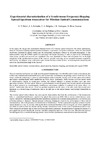Please use this identifier to cite or link to this item:
https://accedacris.ulpgc.es/jspui/handle/10553/46531
| Title: | Experimental characterization of a synchronous frequency-hopping spread-spectrum transceiver for wireless optical communications | Authors: | Pérez, S. T. Rabadán, J. A. Delgado, F. A. Velázquez, J. R. Pérez Jiménez, R. |
UNESCO Clasification: | 3307 Tecnología electrónica | Keywords: | wireless optical communications spread spectrum frequency hopping synchronism pilot signal CDMA |
Issue Date: | 2003 | Journal: | Proceedings of SPIE - The International Society for Optical Engineering | Conference: | Conference on VLSI Circuits and Systems VLSI Circuits and Systems |
Abstract: | In this paper, the design and experimental characterization of a wireless optical transceiver for indoor applications, based on Frequency-Hopping Spread-Spectrum techniques, is presented. Using these techniques reduce the narrowband interference produced by optical sources and the intersymbol interference induced by multipath propagation. It also makes possible using the CDMA capabilities associated with Spread Spectrum, in order to improve the performances when several emitters and receivers are considered. The main drawback of these kind of systems lies on the high complexity of the synchronization system of the receiver, typically consisting on two cascaded structures: acquisition and tracking. We propose using a dual-pilot signal, transmitted by a master emitter, for reducing both complexity and cost of the synchronization stage of the receiver. | URI: | https://accedacris.ulpgc.es/handle/10553/46531 | ISBN: | 0-8194-4977-6 | ISSN: | 0277-786X | DOI: | 10.1117/12.498729 | Source: | Proceedings of SPIE - The International Society for Optical Engineering[ISSN 0277-786X],v. 5117, p. 506-514 |
| Appears in Collections: | Actas de congresos |
Page view(s)
66
checked on Jan 27, 2024
Download(s)
243
checked on Jan 27, 2024
Google ScholarTM
Check
Altmetric
Share
Export metadata
Items in accedaCRIS are protected by copyright, with all rights reserved, unless otherwise indicated.
